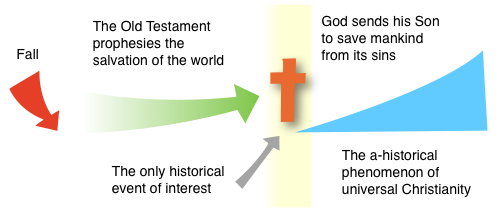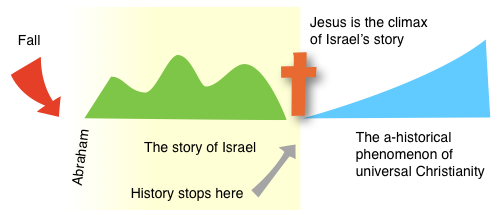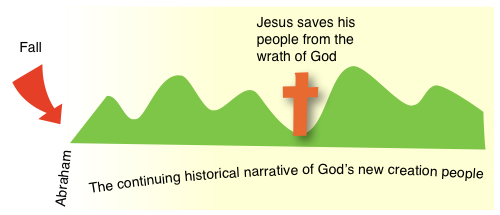I argued in “The story of how Jesus died for everyone (longer version)” that the account of Jesus’ death in Hebrews highlights both the constraints of the Jewish narrative and the importance of the martyrdom motif for soteriology. I suggested that the “saving significance of Jesus’ death is mediated to the world precisely through the story of the suffering of the early martyr church”. Having reflected on a brief exchange with Peter Wilkinson that ensued, I have sketched here, very roughly, what seem to me the three main ways in which we can locate the event of Jesus’ death and resurrection in history.
The a-historical paradigm

The popular or traditional understanding of Christianity has Jesus arrive more or less out of the blue in the centre of world history to save mankind from its sins. The Old Testament is useful because it contains prophecies of this singular event, but the history of Israel is largely irrelevant. The church is the institutionalized—sometimes highly institutionalized—outcome of the universal salvation that is found in Christ. Its mission is mainly to convert, assimilate, and expand until Jesus returns.
The half-historical paradigm

This view fully embraces the historical narrative leading up to Jesus, but once we have arrived at the climax of the covenant, the climax of God’s redemptive purposes through Israel, history as theologically significant narrative comes to an abrupt halt. Then we revert to the a-historical paradigm. After Pentecost the next event of theological significance is the second coming of Jesus at the end of the world. The half-historical people sometimes acknowledge the importance of the destruction of Jerusalem and the temple as the dreadful terminus of the Old Testament story. The main gain from taking the Old Testament narrative more seriously is a broader sense of the corporate nature of the church as an extension of the concrete existence of Israel.
The consistent historical paradigm

My preferred consistent narrative-historical paradigm inserts the event of Jesus’ death and resurrection firmly into the continuing existence of a people that finds its identity and purpose in the calling of Abraham to be the father of a new creation. The people of God is radically changed by this event: it becomes a supra-ethnic community of the Spirit under the lordship of Jesus that will, in some sense, inherit the world. But the basic template remains the same: it is new creation in microcosm in the midst of the nations, for the sake of the creator God.
Under this paradigm theologically significant history does not stop with Jesus. Subsequent events are just as important, whether predicted by the New Testament (the destruction of Jerusalem, the vindication of the suffering churches, the defeat of pagan Rome), or not (the collapse of Christendom, the triumph of secular rationalism, and so on, indefinitely).
Great stuff, thanks for clarifying the distinctions. Here's a thought: part of what might be difficult of thinking along your "consistent historical paradigm" is the fact that the history the biblical narrative itself tells only goes into the first-century, though it likely projects certain likely historical events into the next couple of centuries as you argue. But all of subsequent historical events of the church and societies in which the church exists are not only not a part of our controlling narrative, but also these events are myriad, spinning into difficult places, peoples, and cultures not told in our standard history books. I realize you're not arguing for a continuing authoritative narrative, but I wonder then what the practical difference would be between option 2 and 3, for folks represented by option 2, I would think, definitely affirm the Spirit's continued work in and through the historical events of the church subsequent to the first few centuries. Am I making any sense? What am I missing?
@Wesman:
Good questions. I tried to answer them in a new post.
Some very odd things happen with the third paradigm though. The focus of the narrative becomes "identity and purpose in the calling of Abraham to be the father of a new creation", rather than Jesus as the fulfilment of that narrative, which is where the focus of the NT clearly lies on every page (not least in what it says about Abraham).
From this perspective, what is the purpose of history now? A continuation in each generation of the worldwide spread of the kingdom of God (Matthew 13:1-52 in its broader historical context), in which the activity of the kingdom challenges the values and activity of the 'old creation' in all its aspects, and provides transformed alternatives, albeit in part.
Here, 'kingdom' means the dynamic and continuing interaction between the kingdom's executive power, the Spirit, and the world in which God expresses his redeeming intentions and authority through his delegate, Jesus.
The decline of pagan Rome was one such transformation; the challenge to its successor was more complex, but just as necessary. The challenge to modernity, which spawned secular rationalism, the rebellious off-spring of the church, is also just as important, as is now the challenge to post-modernity.
The challenges are complex, in that each development of culture brings characteristics that can be affirmed as well as those that need to be confronted. The church will always, to some extent, reflect the culture, as well as needing to challenge culture. In that rather difficult balancing act, it will always, inevitably, to some extent adopt too much of the culture, or contrarily challenge culture unnecessarily and pointlessly.
This is the historical process, in which church and faith continue to respond to history, existing between the world of the transcendent and the world of the immanent. This is our calling and mandate - to continually bring the values and life of the kingdom to bear on a world which will continue to need it, in measure receiving or rejecting it. A-historical in this sense means existing between the two worlds, where one world is a-historical. We can no more dismiss the a-historical than be without a God who lives and is active in and between both heaven and earth.
@peter wilkinson:
…rather than Jesus as the fulfilment of that narrative, which is where the focus of the NT clearly lies on every page…
Yes, the New Testament focuses overwhelmingly on Jesus, but, I would argue, in a way that re-asserts the historical missional existence of the people of God. I think it is misleading to speak of Jesus simply as the “fulfilment” of the Jewish narrative. The basic fact of lordship presupposes the continuation of the narrative about the missional existence of the people of God. I would argue that evangelicalism has taken Jesus out of context and inflated his significance—admittedly for good reasons—in isolation from the story of the people.
From this perspective, what is the purpose of history now? A continuation in each generation of the worldwide spread of the kingdom of God (Matthew 13:1-52 in its broader historical context), in which the activity of the kingdom challenges the values and activity of the ‘old creation’ in all its aspects, and provides transformed alternatives, albeit in part.
That begs the question of how “kingdom” is to be understood. I think your way of putting it rather misrepresents Jesus. I disagree, for example, with the statement that the parable of the mustard seed refers to the “worldwide spread of the kingdom of God”. In Matthew 13 “kingdom” has to do entirely with what God is about to do in Israel.
And what does it mean to say that the “activity of the kingdom challenges the values and activity of the ‘old creation’ ”? The kingdom is not some visible, tangible thing apart from the people of God. Either the people of God challenges, etc., or nothing does. Kingdom has to do with the relation of God to his people. The people of God is the sole concrete agency of God’s action and presence in the world.
@Andrew Perriman:
Andrew - I wasn't expecting you to agree with any of my comment, especially my understanding of kingdom and Matthew 13!
I'm simply setting out the alternative construct - based on an alternative framing of what the biblical narrative is, which Jesus came to fulfil.
Fulfil it he did, according to this construct. The church continues his ministry, through his life, not its own. The church has no separate existence from him.
In this interpretation of the story, the church continues in close interaction with history - there is no separation into a metaphysical flight into hyperspace.
The story as told by this construct does not come to different conclusions from the story told throughout history, let alone in modern evangelicalism. It simply gives a much richer way of understanding the story, which brings the entire story into play.
Incidentally, I don't think the church is in crisis. There may be an ebbing and flowing of belief, in Europe and North America especially. Otherwise it now constitutes approximately 1/3 of the world's population, growing faster than the birth rate in some parts of the world.
That's not to say there aren't significant challenges, but these can be faced, and generally are, despite problems alluded to in my post.
I'm on board with the third illustration. I would just have a large spike at the cross (and include the empty tomb).
Shalom
I think the effort to understand the intent of the trajectory of Christianity through what happened in European Christianity in the last 2,000 years misses not only the trajectories of other churches (specifically, the Church of the East until their destruction by Islam) but tends to imply that 2,000 years represent a relatively important benchmark. The Church of the East (per Broadbent) was geographically larger and probably had more converts than any combination of western churches in its era. Most of the original Disciples are said to have died in the region represented by that church. It was essentially destroyed (though there is a remnant) by Islam as it grew. So, if you lived east of Damascus in 800AD, as that church was being slaughtered, do you think you'd have been speculating about how to re-image the church in that region? And, would you be wondering what the point of Christianity was since your church was being extinguished?
I try to think of what is going on in Western Christianity from the notional point of view of 10,000AD (or maybe 100,000AD). Looking back, we were a significant but temporary blossoming of the message of Christ. I have no doubt that the kingdom itself will increase with no end (per Ezekiel 47 and other passages), but that doesn't mean a given geographical (or civilizational) church will increase if it becomes apostate. What's important is that the remaining churches stay faithful to the basics as they add complexities.
I think that a better explanation would be one that splits the difference between the half-historical and the historical paradigm. Under the half-historical paradigm you have Israel's history stopping. Per Isaiah 60ff, Israel's history didn't stop. Israel defined under the Mosaic Law was put to the sword, but the faithful remnant and the Gentiles were defined as a new people under the New Covenant. In that sense, Israel continued, though as only faithful followers. Starting from Deut.32 the Bible presents a clear before and after theme to the storyline, and "after" is the new people called by a new name who take advantage of the New Covenant. You might call this a-historical in as much as there is no Biblical narrative describing the events that will take place. But, I think this goes too far since there are all sorts of descriptions of the characteristics of these people.
@Doug in CO:
Doug, thanks for the thoughtful comment. My first objective has been not so much to understand the “trajectory of Christianity” in toto but to understand the trajectory of New Testament apocalyptic. It seems to me that the main trajectories of New Testament thought land at the victory of Christ over the gods of the Greek-Roman world and the deliverance of the faithful communities of his followers from persecution. That makes the conversion of Rome a theologically important event, though not an absolute one. My argument is simply that the New Testament, like the Old Testament, deals with history.
My second concern has been with making sense of the situation of the Western churches—especially from an evangelical or post-evangelical perspective—now that their cultural and political hegemony has been reversed. What are the implications for mission, in particular, of the fact that the modern “empires” in which we are located no longer confess—or even pretend to confess—Jesus as Lord?
Naturally it is much easier for me as a non-historian to treat everything between as a rather undifferentiated historical development—the rise and fall of Western Christendom. That approach certainly needs qualification, but it still seems to me that the global church today is for the most part directly descended from the conversion of Europe, and so its theology is the product of the initial Hellenization of the Jewish narrative and carries the distortions of that process. If the Church of the East had survived as a major voice in the history of Christianity, perhaps things would have been different, though it probably would not have done any better at preserving the narrative-historical character of the New Testament.
I agree that we have to see the church as a continuation of the Old Testament people of God. My main reason for sticking with the consistent historical paradigm here is that I think the New Testament does foresee a concrete extension of the narrative, in the form of apocalyptic, into its immediate future (the two eschatological horizons of AD 70 and God’s judgment of Rome), and that these prophecies and their fulfilment are critical for understanding New Testament theology as a whole. That seems to me to be an important part of how the New Testament engages with history.
@Andrew Perriman:
I agree with you that keeping our world view connected to what Christianity understood in that critical triumphant era around the converstion of Rome is important. I suggest to accomplish that means to embrace a simple Ante-Nicene system of atonement similar to that proposed in "Moral Transformation" by Wallace and Rusk, a "power under" approach to politics as advocated by Gregory Boyd, and a Christian culture that expects martyrdom. None of these three suggestions is an easy pill to swallow in the Christian west that is used to being merged with the state for the last 1,600 years. But, they are the engine that got us the original victory and I think a solid foundation for growing an effective second western Christian civilization.
@Doug in CO:
I'll blame my failure to include a covenantal element on writing my three suggestions above at 2:00 a.m. (a poor excuse). Of course, I think a fourth element should be to understand the church as the Israel of God, which is to say that it is the New Covenant church that takes advantage of the Old Testament promises and mandates to spread the news of the Kingdom of God to all men around the world.
Recent comments